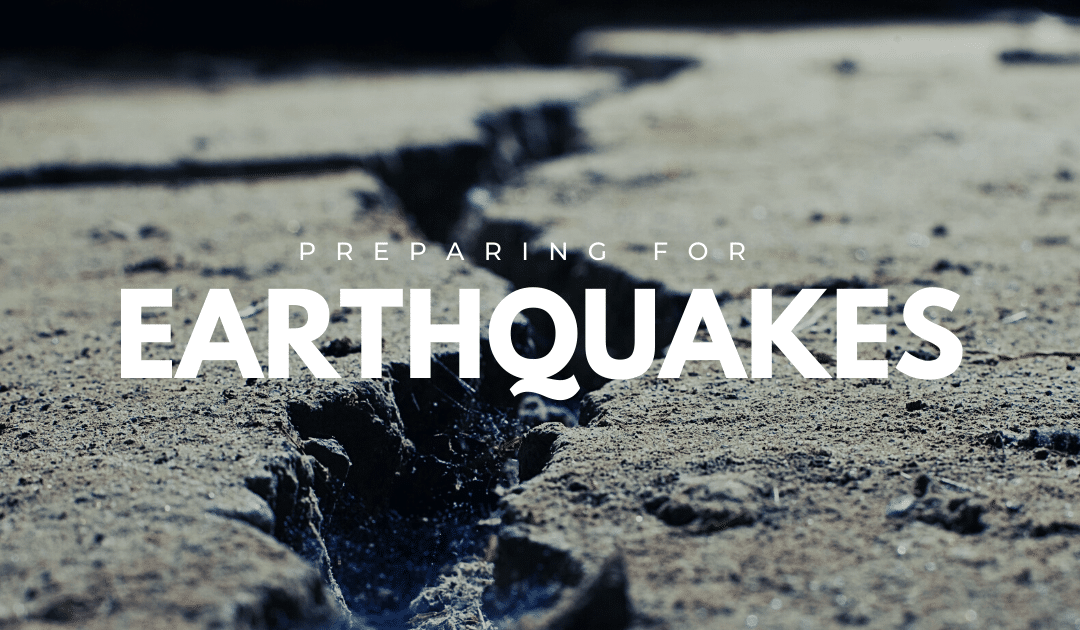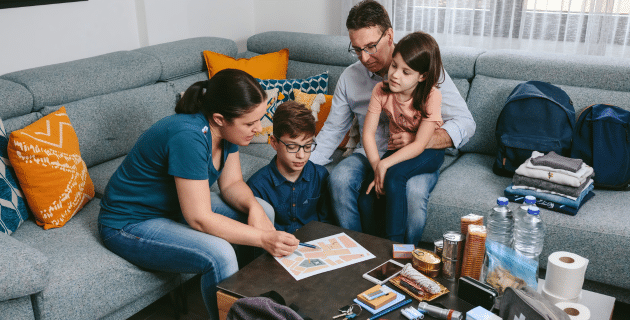
by California Casualty | Homeowners Insurance Info, Safety |
Chances are good that if an earthquake hits, you’ll be at home — especially now, when many of us are working at home due to coronavirus.
Luckily, there are simple things you can do today to safeguard your home and better protect yourself and your family before an earthquake strikes. Start with our 12 to-dos below. You’ll also find 3 top tips for what to do during a quake and, just as importantly, what not to do.
Inside Your Home
Whether it’s the kind that rolls in waves or arrives with a sudden jolt, an earthquake will surely shake your home and its contents. More people are injured by falling objects or furniture than by building damage. Make your home safer by securing and moving furniture and accessories, especially where people sit, sleep, or spend a lot of time. Pay special attention to heavy objects: move them lower to ground level and also make sure they’re not close to escape routes or doorways. Here are 12 other items to check and secure:
-
- Bookshelves – Tall bookshelves are an accident waiting to happen, as they’re unstable to begin with, and their contents can easily become airborne. Secure them to a wall stud using L-brackets and place the heaviest items on bottom shelves.
- Chemicals – If you have chemicals stored on open shelves in the garage or basement, protect them against spills by installing wood, plexiglass strips or wires to restrain them. If containers are behind cabinet doors, use latches to secure the doors.
- Display Cases – Secure these to the floor using appropriate brackets. Install safety glass if possible. Try to secure shelves inside the case as well.
- Electronics – For large electronics such as flat-screen TVs and entertainment centers, buy a “safety strap” kit, which contains straps and buckles designed for these heavy electronics.
- Hanging Objects – These are especially prone to be thrown around in a quake. Framed pictures and mirrors should be hung from closed hooks so they can’t bounce off walls. You can also use earthquake putty to secure corners. Move medium or large-sized pieces so they’re hung on studs, which is more secure being hung on drywall only. Make sure any hanging plants are well away from windows.
- HVAC Units – Anchor units using restraint brackets or seismic snubbers.
- Kitchen Cabinets – Shaking can cause cabinet doors to fly open and throw contents onto the floor. This can lead to a floor full of glass and ceramic shards – not to mention damage to countertops and walls. Secure cabinets by installing one or more of several latches: hook and eye, standard latch, pull/throwover, push latches, child-proof, or seismolatch.
- Piping – Secure all overhead pipes using brackets.
- Refrigerator – Secure refrigerators and other major appliances to wall studs using earthquake appliance straps.
- Space Heaters – These should be equipped with support legs and properly spaced angles. Learn online to DIY or hire a professional.
- Suspended AC Units – These should be braced with angles or welded to a support rod.
- Water Heater – Proper fastening involves having 2 straps that wrap completely around the unit and are screwed into studs of the wall.
What to Do During a Quake
The more you move or try to run during an earthquake, the greater chance you’ll be injured by falling or flying objects. Instead, remember to:
1. Drop to hands and knees – Do this before the earthquake knocks you down. It protects you from being thrown down and allows you to move if you need to.
2. Cover your head and neck – Get under a sturdy table or desk as soon as you can. If you can’t get to one, get next to low-lying furniture that won’t fall on you or next to an interior wall. Wherever you end up, cover your head and neck for protection.
3. Hold on to your shelter – Hold on to the table or desk (or your head and neck) until the shaking stops. If you’re under a table, be ready for it to shift as the quake rolls – and move with it.
What NOT to Do
1. Run outside – A building’s exterior walls are the most dangerous place to be during a quake. Facades, windows, and architectural details are often first to collapse or break. If you’re inside, don’t run outside, and if you’re outside, don’t run inside – crossing the building exterior puts you at risk of being injured by falling debris.
2. Stand in a doorway – It’s a long-held idea that a doorframe is the safest place to be. In modern homes, a doorframe is no safer than any other part of the house and won’t protect you from airborne or falling objects. You’re safer under a sturdy table.
3. Get in the “triangle of life” – An email that’s gone viral in the last few years offers advice counter to the long-established “Drop, Cover and Hold On” advice. The actions outlined have been discredited as potentially life-threatening by experts and their organizations.
Earthquake safety really boils down to preparation. Although you can’t control where you’ll be when one hits, you can prepare yourself and your home starting right now. Between the tips above – and our articles on what to do before and after a quake and emergency kit basics – you’ll be well on your way to pro-level preparation.
This article is furnished by California Casualty, providing auto and home insurance to educators, law enforcement officers, firefighters, and nurses. Get a quote at 1.866.704.8614 or www.calcas.com.

by California Casualty | Auto Insurance Info, Safety |
While there may be fewer people on the road these days, there is an increase in reckless and dangerous driving, resulting in more accidents — and sadly, fatalities.
Even for the best driver, intersections are some of the most dangerous places on the road. It’s really no surprise, though, given all the commotion concentrated in a small space: vehicles crossing each other’s paths, signals, signs, honking, merging lanes, pedestrians and bicyclists. Add in the all-too-common confusion many drivers experience around right-of-way, and you have a recipe for a fender bender or worse.
By brushing up on the traffic rules for intersections, you can feel more confident in safely maneuvering them. Here are some simple right-of-way reminders, listed by intersection type.
A Four-Way Stop
This is the most common type of intersection, where two roadways cross each other.
-
- Yield to drivers who’ve arrived before you. The first car to arrive always receives the right of way.
- If you arrive at the same time as another driver, the one who’s farthest to the right gets the right of way.
- If three vehicles arrive at the same time, the rule of “right-most has the right of way” still holds, and the car farthest left goes last.
Intersection Without a STOP or YIELD Sign
Known as an “uncontrolled” intersection due to lack of signs or signals, these often trip people up.
-
- Yield to drivers already in the intersection or those who’ve arrived before you.
- If you arrive at the same time as another, the right-most vehicle has the right of way.
A T-junction (Three-Way Intersection)
This is where a minor road dead-ends into a major roadway.
-
- Vehicles on the major road (the through road) always have the right of way.
- If you’re entering from the minor roadway, you must come to a complete stop and yield to drivers on the through road, no matter which way you’ll be turning.
A Traffic Circle
Also called a roundabout, this is an intersection of four or more roadways that converge into a single road that flows in one direction around a center island.
-
- When approaching the circle, always slow and yield to the vehicles in the traffic circle.
- Merge by turning right so that you’re driving around the circle in a counterclockwise direction.
- Turn right to exit the circle when you reach your roadway.
- Do not stop in the roundabout – a steady flow and speed is critical to safety.
U-Turns or Left Turns Onto Two-way Roads
-
- You’re basically last in line: Don’t turn until you yield to oncoming cars, motorcyclists, bicyclists, and pedestrians.
- Keep in mind that both of these turns carry extra risk, so remember safety first, always.
Besides employing the rules above, remember to always slow down and pay attention when approaching intersections. This is a winning combo for smoothly navigating any intersection and getting to where you’re going safely.
This article is furnished by California Casualty, providing auto and home insurance to educators, law enforcement officers, firefighters, and nurses. Get a quote at 1.866.704.8614 or www.calcas.com.

by California Casualty | Auto Insurance Info, Safety |
Late summer riding beckons; open roads, open skies, long days, and beautiful sunsets. The flipside? Extreme heat. And also a transition period of reacquainting yourself with the roads and traffic. Use these tips to keep your bike and yourself cool and safe.
For Your Bike
Keeping your ride cool and running smoothly through the summer usually entails a little extra maintenance. Here are some of the priority areas to fitness-check before setting out.
- Tires – Tire blowouts are usually caused by underinflated, rather than overinflated, tires. Make sure to inflate to the manufacturer’s recommended PSI. And remember that high external temps cause tire pressure to increase due to expanding gas. Check them each week and adjust as necessary. Also keep an eye on the tires’ condition, looking for any cracks, punctures, bulges, or worn tread.
- Fluids – Check oil, brake, coolant, hydraulic fluids, and their reservoirs for debris, condensation, and discoloration or changed consistency. Get them changed if they’re due. Check the water pump and hoses regularly for leaks, cracks, and tears. Pro tip: cover your radiator to keep the engine cool (and protect it from dirt, bugs and UV rays). On the hottest days, avoid stationary idling to prevent engine overheating.
- Gas tank – If your bike has been sitting all winter with fuel in the tank, it might not start up. Drain the tank — if there’s any brown grit in the fuel, your tank has probably rusted. You can take it to a mechanic or DIY by flushing with acid remover. After cleaning, treat the new gasoline with a fuel stabilizer.
- Electrical connections – If your electrical connections aren’t secure, the moisture from humid environments can short the connection and stop your bike from functioning. Inspect all wires and connections to components (including battery) and fasten any loose ones. If they’re corroded, it’s best to replace them.
For You
Riding in extreme heat can increase your chance of health risks, overheating, and accident risk. Follow these tips to stay safe and comfortable.
- Hydration – Staying hydrated is one of the best preventive measures for summer riding. Drink water at every stop and consider purchasing a CamelBak for extended rides. Avoid alcohol, as it can easily dehydrate you.
- Sun safety – Even if it’s overcast, you’re still getting hit by UV rays. Wear sunscreen and reapply to exposed skin as often as possible.
- Clothing – Safe riding means extra layers, even in the summer heat. Here are some hacks to keep you cool in your gear.
- Form-fitting sportswear can keep your body temperature down – look for moisture-wicking fabric.
- A lightweight base layer under your jacket and pants can prevent discomfort and keep you dry.
- When leather pants are too hot, check out specialized jeans that have Kevlar fabric lining and other safety components. Never wear shorts.
- Opt for ventilated summer-weight boots, which allow airflow to cool the feet and ankles.
- Mesh-backed gloves will let you grip the handles while allowing for ventilation – as well as hand protection in case of a fall or skid.
- There are options for jackets that protect while keeping you comfortable in the heat. Ventilated jackets with mesh panels allow for aeration, and many perforated leather jackets come with zip vents, which help you release body heat.
- A proper helmet – required by law in all but 3 states – is safety rule number one. Investing in a breathable, lightweight and ventilated helmet will keep your head (and by extension, your body) cool and protected. The best ones are usually carbon fiber.
Get Re-Accustomed to the Road
If you’ve been traveling mostly by car and are just getting back to the roads on 2 wheels, give yourself some time to re-adjust. You no longer have the wrap-around metal protection of a vehicle, and you may need to fine-tune your reaction time for sharing the road with cars.
Most motorcycle accidents are attributed to unsafe lane changes, car doors, speeding, sudden stops, left-turn accidents, and lane splitting, among others, so make sure you’re visible to the cars around you.
Finally, know the signs of heat stress (check out our article here). It can come on suddenly, so knowledge and prevention are your tools to stay cool and healthy.
This article is furnished by California Casualty, providing auto and home insurance to educators, law enforcement officers, firefighters, and nurses. Get a quote at 1.866.704.8614 or www.calcas.com.

by California Casualty | Homeowners Insurance Info, Safety |
An earthquake, flood, fire, or severe storm can strike at any time — and you and your family may not be together when it does.
How will you find each other if separated? What about household members who have medical conditions? And what if your cell phones or networks are out of power?
Crafting an emergency plan before a disaster hits gives you time to discuss your family’s needs and circumstances, review possible scenarios, and decide on the best options together. Schedule a time when the whole family can participate. You may need one or two additional meetings to finalize all the details.
Here’s what you’ll need to cover:
1. Make A Plan of Action
Smart planning entails talking through a number of situations and “what-ifs.” Start by brainstorming around the following (and remember that coronavirus may affect some answers).
- What natural disasters are we most likely to experience?
- How will we receive emergency alerts and warnings?
- What are the escape or evacuation routes from our house?
- What is our shelter plan?
2. If Your Family is Separated
Re-opening across the country means parents may be going back to work and kids back to school. Are there other locations, such as after-school programs, childcare, gyms or volunteer sites that family members regularly attend? Consider those when answering the following:
- If separated during an emergency, where should we meet near our home?
- If meeting near home is impossible for some or all family members, what’s our meeting place?
- If we are separated, who is our emergency contact outside of our immediate area?
3. Specific Needs of Family Members
Remember to tailor your plan to address any particular needs of/by family members, such as:
- Medical needs including prescriptions and equipment
- Dietary needs
- Medical conditions, disabilities or functional needs, especially those requiring devices and equipment
- Language barriers or limitations
- Ages of all household members, including school-aged children
- Pets or service animals
- Religious and cultural considerations
5. Fill Out the Plan
After discussing the above, it’s time to get it all down on paper. Be sure to capture the following as well.
- All the contact information for each household member.
- Who’s responsible for what during the disaster? Tasks might include things like retrieving the disaster kit, evacuating pets, and fielding disaster updates and alerts.
- Create a personal network of friends, family or neighbors for things you might need help with.
- Make sure you have one or more out-of-town contacts for emergencies.
- Numbers for important contacts such as utilities, financial companies, childcare and caregivers, veterinarians, and insurance companies.
6. Share & Practice
During an emergency, cellular networks and wi-fi may be unreliable, and computers and phones may be lost or out of power. In these cases, having a paper copy of your family disaster plan can save precious time, minimize stress and prevent unnecessary emergencies. So, make sure each family member has a copy and carries it with them in a purse, backpack or work bag (here’s a template plan that fits in your wallet). Have regular family meetings to review the plan and practice. Finally, do a thorough review every 6 months or so, to update information or responsibilities.
7. Resources
Check out these resources to get your plan disaster-ready.
The perfect time to make a plan is right now. Getting all your family members on board and in the know sooner rather than later will ensure that you’re all ready when you need to be.
This article is furnished by California Casualty, providing auto and home insurance to educators, law enforcement officers, firefighters, and nurses. Get a quote at 1.866.704.8614 or www.calcas.com.
by California Casualty | Homeowners Insurance Info, Safety |
Warmer weather is on the horizon and you know what that means? it’s time to break out the gas and charcoal and grill up some juicy meals! But even grilling comes with its fair share of hazards. A small grill fire could easily lead to a home in flames. In fact, on average 10,200 house fires are started by grills each year, which estimates to be about a combined $37 million in property loss.
So, whether you are grilling for enjoyment, to host family and friends, or just for that savory flavor of summer, follow these simple grilling safety tips to help prevent a house fire:
1. Grill at least 10 feet from your home or garage
The farther away from any structures or home decor the better
2. Do not grill under any overhangs or structures
This includes branches, wires, carports, awnings, etc.
3. Do not leave your grill unattended
It only takes one minute for a fire to double in size
4. Turn on your grill and light your gas right away
Don’t wait, if the gas builds up it can cause an explosion
5. Make sure your grill is not leaking
Test it! Spray your tank with soapy water, if the water bubbles, you’ve got a leak
6. Keep your grill clean
Caked-on grease acts as fuel and will only make a fire stronger
7. Do not put too much food on at once
-Dripping fat will only make the flames stronger
8. Keep water or an extinguisher close by-
If a small fire were to start, you can catch and extinguish it at the source
9. Never grill indoors
A spark or flare-up could easily catch something on fire, plus grills release carbon monoxide, which can be deadly
10. Let your grill completely cool off before moving or covering it
Wait 2-3 hours after use and touch it with your hands, if it is still warm, then wait another 2-3 hours before moving or covering
While you’re enjoying your burger, all it takes is one ember on a cooling, unattended grill to bring your whole home down in flames. Have peace of mind knowing that should anything happen, your home will be protected by the proper homeowner’s insurance coverage.
This article is furnished by California Casualty, providing auto and home insurance to educators, law enforcement officers, firefighters, and nurses. Get a quote at 1.866.704.8614 or www.calcas.com.

by California Casualty | Homeowners Insurance Info, Safety |
According to the National Weather Service, drought conditions are expected to persist through the summer across many western states. If you’re a homeowner in a drought-prone area, that means monitoring water usage, thinking ahead to fire prevention and safety, and maintaining landscaping with drought tolerance in mind.
But there’s one more thing to think about: your foundation.
Drought threatens the integrity of your home’s structure in many ways and can end up costing tens of thousands in foundation repairs if problems are not caught early. Here are some of the most common signs of foundation stress or damage, and what you can do about it.
What’s Going On Under Your House?
When dry conditions persist, the soil under your home can lose enough moisture that it shifts and buckles, causing your foundation to crack. When rain finally returns, the soil soaks it up and expands, lifting up your foundation again, which can cause more cracking or unevenness. If your home, like most, has tree roots under it then the roots can draw moisture from the soil, adding to the problem.
Signs You Have a Problem…
A cracking foundation can cause a domino effect of problems up through the house. Here are some signs you might have issues.
-
- Cracks in rigid wall surfaces such as brick, concrete, stucco, tile, and drywall
- Windows and doors that begin sticking or become misaligned
- Leaks in the basement
- Broken pipes
- Gaps along cabinets, baseboards or outdoor trim
- Misalignment where your foundation meets an exterior wall
- Floors that sink or slope
- Cracked basement floor
- Cracked or shifted chimneys
- Cracked asphalt and pavement on driveways or walkways
What To Do About It
Do a careful inspection of your home inside and out. If you see cracks, take photos, measure, and record them so you have a history to compare with in the future. If the cracks are minor or few, just keep an eye on them. If you see anything serious or worrying, contact a professional. You want to prevent any foundational issues before they cause serious (and expensive) damage. Here are some preventive measures you can take to keep the ground under your home moist:
-
- Install a water system around your home.
- Add a few inches of mulch to your landscaping area.
- Plant drought-tolerant and fire-resistant shrubs and groundcover, which will hold moisture in the ground and keep it shaded, preventing evaporation.
- Keep up with weeding (weeds are thirsty).
- Plant any new trees far enough from the foundation to keep roots at a distance.
- As always in drought-prone areas, practice water conservation inside and outdoors.
Catching foundation problems before they get serious entails some extra time and attention on your part but will help you avoid costly repairs or even replacement of your foundation.
This article is furnished by California Casualty, providing auto and home insurance to educators, law enforcement officers, firefighters, and nurses. Get a quote at 1.866.704.8614 or www.calcas.com.





